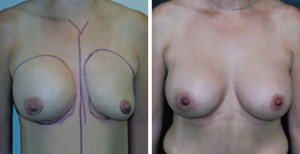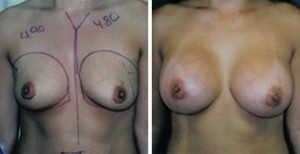Beverly Hills Breast Asymmetry, What To Do
Posted On: March 03, 2009 Author: The Office of Dr. Stuart Linder Posted In: Breast Asymmetry, Home
Dr. Linder specializes in breast augmentation and breast revision surgery. Patients present with breast asymmetry almost weekly. Fixing breast asymmetry can be tricky and does require skill, experience and judgment as can be found with most Board Certified Plastic and Reconstructive Surgeons.
 Breast asymmetry can be congenital which often presents with a larger saggy breast on one side and a smaller, more conical or tubular shape breast on the other side with poor or arrested development. To repair these, usually the smaller breast only requires an implant as long as the nipple is above the inframammary fold. The larger breast which is saggy, will require a smaller implant obviously, as well as a breast lift.
Breast asymmetry can be congenital which often presents with a larger saggy breast on one side and a smaller, more conical or tubular shape breast on the other side with poor or arrested development. To repair these, usually the smaller breast only requires an implant as long as the nipple is above the inframammary fold. The larger breast which is saggy, will require a smaller implant obviously, as well as a breast lift.
The breast lift normally will either be a vertical or a formal mastopexy using an inferior pedicle Wise-pattern or an anchor scar. Implants of different sizes can be used. In general, we prefer to use saline implants with significant breast asymmetries because we can titrate the volume of the implants which can lead us to more precision, accuracy and final breast volume.
 Silicone gel implants, however, can be used if the asymmetry is slight and not too significant. Breast asymmetries are seen in most women, at least slight asymmetry, however, when they become significant, they can be physically and psychologically tormenting to the woman’s self-esteem. Repairing asymmetries, once again, usually requires placing the implant, either saline or silicone, in a dual plane (half under and half over the muscle or two-thirds under, one-third over depending upon the thickness of the muscle), as well as reconstruction and removal of skin on the saggy breast side, which can be performed by simply removing skin around the areola and along the vertical plane and along the inframammary fold. To completely correct breast asymmetry, the absolutely correct breast lift must be performed. When a patient has grade 3 ptosis and the nipple is well over 3 cm below the inframammary fold, a formal mastopexy is usually required and that is an anchor scar.
Silicone gel implants, however, can be used if the asymmetry is slight and not too significant. Breast asymmetries are seen in most women, at least slight asymmetry, however, when they become significant, they can be physically and psychologically tormenting to the woman’s self-esteem. Repairing asymmetries, once again, usually requires placing the implant, either saline or silicone, in a dual plane (half under and half over the muscle or two-thirds under, one-third over depending upon the thickness of the muscle), as well as reconstruction and removal of skin on the saggy breast side, which can be performed by simply removing skin around the areola and along the vertical plane and along the inframammary fold. To completely correct breast asymmetry, the absolutely correct breast lift must be performed. When a patient has grade 3 ptosis and the nipple is well over 3 cm below the inframammary fold, a formal mastopexy is usually required and that is an anchor scar.
When patient have a conical or tubular breast on one side, this can be easily enhanced with a larger saline or silicone implant and release of the tubular inferior pole of the breast with radial striations of the lower pole above the pectoralis major fascia is performed in order to round out the lower pole of her breast.
Dr. Linder enjoys fixing breasts from patients throughout the world and right here in Beverly Hills. Breast asymmetry is a challenging operation. Only Board Certified Plastic Surgeons should be performing these operations. They have the experience and judgment to allow for a reasonable and favorable result.